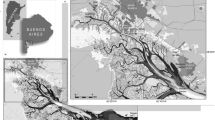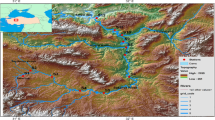Abstract
Eight cruises were conducted on the south Yellow Sea (SYS) from 1998 to 2005. Variations and the potential ecological risk of heavy metals were studied using the survey data collected during October 2003. The metal content (except for As) was high in the central area where the fine grain size sediments were dominant, and low inshore area where more coarse sediments were present. This suggested that grain size was important in determining distributions of heavy metals. In some local areas, other influencing factors, such as organic content, sedimentation rate, burial efficiency and metal’s existing form were discussed. The annual averages of metals showed a stable trend with appreciable fluctuations in 8 years. Using potential ecological risk index (E RI) to evaluate the integrated pollution effect of heavy metals, 38.7% of the investigated area was in a moderate degree of contamination, while 77.8% was under moderate ecological risk. However, no distinct correlation was found between E RI and plankton biomass. In conclusion, the sediment quality of SYS was good, and the ecological risk was low in general.
Similar content being viewed by others
References
Carman, C. M., Li, X. D., Zhang, G., Onyx, W. H., & Li, Y. S. (2007). Trace metal distribution in sediments of the Pearl River Estuary and the surrounding coastal area, South China. Environmental Pollution, 147, 311–323. doi:10.1016/j.envpol.2006.06.028.
Chapman, D. (1992). Water quantity assessment (pp. 121–134). London: Chapman & Hall Ltd.
Chapman, P. M., Wang, F. Y., Adams, W. L., & Green, A. (1999). Appropriate applications of sediment quality values for metals and metalloids. Environmental Science & Technology, 33, 3937–3941. doi:10.1021/es990083n.
Chen, J. L., Liu, W. X., Liu, S. Z., Lin, X. M., & Tao, S. (2004). An evaluation on heavy metal contamination in the surface sediments in Bohai Sea. Marketing Science, 28, 16–21 (in Chinese).
Chen, Z. X., Dong, H. P., Li, S. Q., Yuan, H. M., & Wang, B. J. (2005). Distribution pattern of heavy metals in the surface sediments of the Jiaozhou Bay. Marine Science Bulletin, 7, 41–56 (in Chinese).
Cheng, X. S., Qing, X. G., Liu, F. P. (2005). Determination of trace arsenic in marine sediment sample by atomic fluorescence spectrometry using a slurry sampling technology. Acta Oceanology Sinica, 27, 159–162 (in Chinese).
Dai, W. M. (1994). Forms of heavy metals in the suspended solids of Yangtze Estuary. Shanghai Environmental Sciences, 13, 7–10 (in Chinese).
GB18668 (2002). Marine sediment quality. General administration of quality supervision, inspection and quarantine of the People’s Republic of China. Beijing: China Standard Press
Ghaedi, M., Amini, M. K., Rafi, A., Gharaghani, S., & Shokrollahi, A. (2005a). Adsorptive stripping voltammetric determination of copper (II) ion using phenyl pyridyl ketone oxime. Annali di Chimica, 95, 457–464. doi:10.1002/adic.200590052.
Ghaedi, M., Fathi, M. R., Marahel, F., & Ahmadi, F. (2005b). Simultaneous preconcentration and determination of copper, nickel, cobalt and lead ions content by flame atomic absorption spectrometry. Fresenius Environmental Bulletin, 14, 1158–1163.
Ghaedi, M., Fathi, M. R., Shokrollahi, A., Gharaghani, Sh., & Soylak, M. (2008). Cloud point extraction for the determination of copper ion in environmental samples. Quimica Nova, 31, 70–74.
Ghrefat, H., & Yusuf, N. (2006). Assessing Mn, Fe, Cu, Zn, and Cd pollution in bottom sediments of Wadi Al-Arab Dam, Jordan. Chemosphere, 65, 2114–2121. doi:10.1016/j.chemosphere.2006.06.043.
Hakanson, L. (1980). An ecological risk index for aquatic pollution control: A sedimentological approach. Water Research, 14, 975–1001. doi:10.1016/0043-1354(80)90143-8.
Hu, S. H., Chen, A. F., Lin, S. L., Yuan, H. L., Gao, S. (2000). ICP-MS analytical research into 40 trace and ultra-trace elements in geological samples. Earth Science—Journal of China University of Geosciences, 25, 186–190 (in Chinese).
Li, F. Y., Gao, S., Jia, J. J. (2002). Contemporary deposition rates of fine grained sediment in the Bohai and Yellow Seas. Oceanologica Et Limnologia Sinica, 33, 364–369 (in Chinese).
Li, S. Y., Miao, F. L., & Liu, G. X. (1994). The distribution and environmental background values of the heavy metals in the sediment of the North Huanghai Sea. Journal of Oceanography of Huanghai & Bohai Seas, 12, 20–24 (in Chinese).
Li, S. Y., Miao, F. M., Liu, G. X., & Hao, J. (1995). Study of background value of heavy metals in Bohai Sea sediments. Acta Oceanologica Sinica, 17, 78–86.
Li, X. D., Wai, O. W. H., & Li, Y. S. (2000). Heavy metal distribution in sediment profiles of the Pearl River estuary, South China. Applied Geochemistry, 15, 567–581. doi:10.1016/S0883-2927(99)00072-4.
Li, Q. S., Wu, Z. F., Chu, B., Zhang, N., Cai, S. S., & Fang, J. H. (2007). Heavy metals in coastal wetland sediments of the Pearl River Estuary, China. Environmental Pollution, 149, 158–164. doi:10.1016/j.envpol.2007.01.006.
Li, G. X., Xu, X., & Zhang, J. M. (2006). Determination of available Mn. Cu and Zn in Soil by ICP-MS. 23, 1267–1270 (in Chinese).
Li, F. Y., Yang, Y. L., He, L. J., & Shi, Y. L. (1999). Discussion on sedimentation rates and material source in the east part of the south Yellow Sea. Marketing Science, 23, 37–40 (in Chinese).
Lim, D. I., Jung, H. S., Choi, J. Y., Yang, S., & Ahn, K. S. (2006). Geochemical compositions of river and shelf sediments in the Yellow Sea: Grain-size normalization and sediment provenance. Continental Shelf Research, 26, 15–24. doi:10.1016/j.csr.2005.10.001.
Lin, S., Hsieh, I. J., Huang, K.-M., & Wang, C.-H. (2002). Influence of the Yangtze River and grain size on the spatial variations of heavy metals and organic carbon in the East China Sea continental shelf sediments. Chemical Geology, 182, 377–394. doi:10.1016/S0009-2541(01)00331-X.
Liu, B. J. (1980). Sedimentary petrology (pp. 125–130). Beijing: Geological Publishing House.
Liu, W. X., Li, X. D., Shen, Z. G., Wang, D. C., Wai, O. W. H., & Li, Y. S. (2003). Multivariate statistical study of heavy metal enrichment in sediments of the Pearl River Estuary. Environmental Pollution, 121, 377–388. doi:10.1016/S0269-7491(02)00234-8.
Loska, K., & Wiechula, D. (2003). Application of principal component analysis for the estimation of source heavy metal contamination in surface sediments from Rybnik Reservoir. Chemosphere, 51, 723–733. doi:10.1016/S0045-6535(03)00187-5.
Lu, S. Y., & Zhu, M. Y. (1987). The background value of chemical elements in the Huanghai sea sediment. Acta Oceanologica Sinica, 6, 72–86.
Ma, M., Feng, Z., Guan, C., Ma, Y., Xu, H., & Li, H. (2001). DDT, PAH and PCB in dediments from the intertidal zone of the Bohai Sea and the Yellow Sea. Marine Pollution Bulletin, 42, 132–136. doi:10.1016/S0025-326X(00)00118-1.
MacFarlane, G. R., & Burchett, M. D. (2000). Cellular distribution of Cu, Pb and Zn in the Grey Mangrove Avicennia marina (Forsk.), Vierh. Aquatic Botany, 68, 45–59. doi:10.1016/S0304-3770(00)00105-4.
Park, Y. C., & Choi, J. K. (1993). Oceanographical consideration on waste disposal in the marine environment. Journal of the Korean Society of Oceanography, 28, 142–152 (in Korea).
Qin, Y. S., Zhao, Y. Y., & Chen, L. R. (1989). The geography Southern Yellow Sea (pp. 20–86). Beijing: Marine.
Ravanelli, M., Tubertini, O., Valcher, S., & Martinotti, W. (1997). Heavy metal distribution in sediment cores from western Ross Sea (Antarctica). Water, Air, and Soil Pollution, 99, 697–704.
Reddy, M. S., Basha, S., Sravan Kumar, V. G., Joshi, H. V., & Ramachandraiah, G. (2004). Distribution, enrichment and accumulation of heavy metals in coastal sediments of Alang-Sosiya ship scrapping yard, India. Marine Pollution Bulletin, 48, 1055–1059. doi:10.1016/j.marpolbul.2003.12.011.
Sari, E., & Cagatay, M. N. (2001). Distributions of heavy metals in the surface sediments of the Gulf of Saros, NE Aegean Sea. Environment International, 26, 169–173. doi:10.1016/S0160-4120(00)00097-0.
Shi, X. F., Chen, C. F., & Liu, Y. G. (2002). The grain size tendency analysis and the schlepping effect of the sediments in the middle of the Southern Yellow Sea. Science Transaction, 47, 452–456 (in Chinese).
Song, J. M. (1997). Chemistry of sediment–seawater interface of the China Seas (pp. 89–94). Beijing: Ocean.
Tanner, P. A., Leong, L. S., & Pan, S. M. (2000). Contamination of heavy metals in marine sediment cores from Victoria Harbour, Hong Kong. Marine Pollution Bulletin, 40, 769–779. doi:10.1016/S0025-326X(00)00025-4.
Tessier, A., Campbell, P. G. C., & Bisson, M. (1979). Sequential extraction procedure for the speciation of particulate trace metals. Analytical Chemistry, 51, 844–851. doi:10.1021/ac50043a017.
Wang, J. Y., Ma, D. Y., & Bao, Y. G. (2003). Evaluation on sediment quality in Yellow Sea and East China Sea. Marine Environmental Science, 22, 21–24 (in Chinese).
Yang, M., Kostaschuk, R., & Chen, Z. Y. (2004). Historical changes in heavy metals in the Yangtze Estuary, China. Environmental Geology, 46, 857–864. doi:10.1007/s00254-004-1072-6.
Yuan, X. Y., Liu, H. Y., Xu, N. Z., Zheng, R. H., & Wang, A. H. (2003). Chemical composition and heavy metal characteristics of sediments in the coast, northern Jiangsu Province. Resources Survey & Environment, 24, 204–210 (in Chinese).
Zhang, L. C., She, Z. S., & Zhang, S. (1996). Study of water environmental chemistry (pp. 247–259). Beijing: China Environment Sciences Press.
Zhang, H., Xia, N., Song, S. Q., Liu, C. L., & Xu, T. T. (2003). Study on analytical method for mercury in marine sediment. Chinese Journal of Spectroscopy Laboratory, 20, 859–863 (in Chinese).
Author information
Authors and Affiliations
Corresponding author
Rights and permissions
About this article
Cite this article
He, Z., Song, J., Zhang, N. et al. Variation characteristics and ecological risk of heavy metals in the south Yellow Sea surface sediments. Environ Monit Assess 157, 515–528 (2009). https://doi.org/10.1007/s10661-008-0552-7
Received:
Accepted:
Published:
Issue Date:
DOI: https://doi.org/10.1007/s10661-008-0552-7




